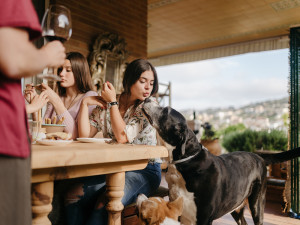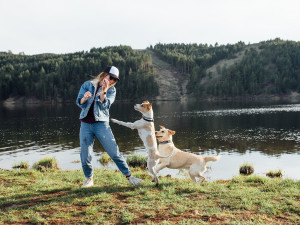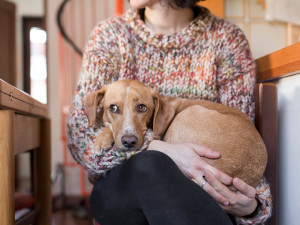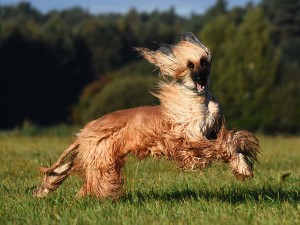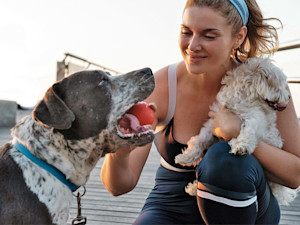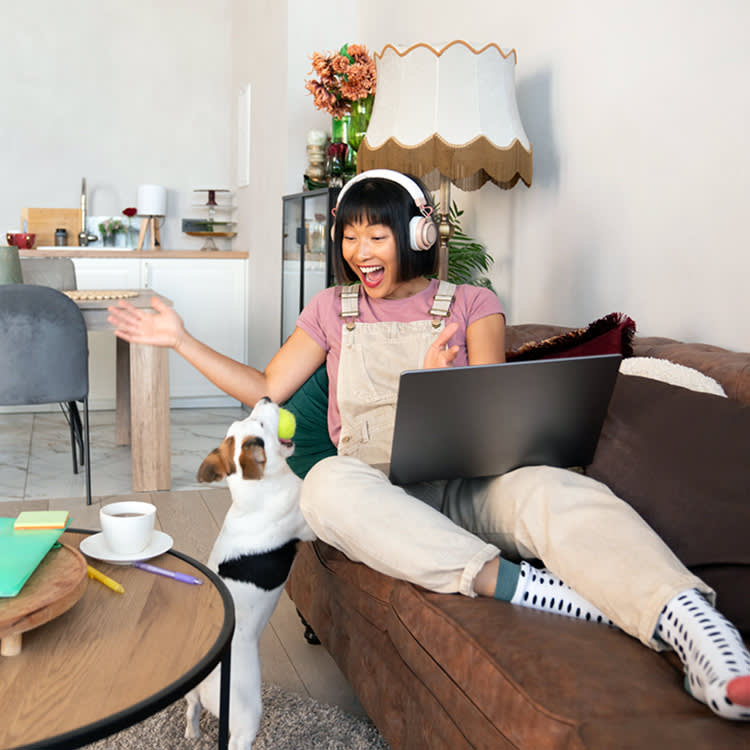
Share Article
In This Article:
Signs of Excitement in Dogs How to Teach a Dog Not to Get So Excited
If you’ve ever noticed your dog’s teeth chattering, it may not be because they’re cold. This behavior is actually common not just in dogs but in cats and other animals as well. And while it can be a reaction to icy temperatures, chattering teeth can also be an expression of pain or even a response to a specific smell in the environment.
Perhaps even stranger: Your dog’s teeth might be chattering because they’re… happy? Dogs tend to use body language to express emotion to their human caretakers, and sometimes they show excitement in rather strange ways.
“Excited dogs often show physical signs like jumping, spinning, tail wagging, or barking,” dog behavior expert and trainer Shelby Semelopens in new tab says. “Their eyes may appear bright, their ears perked, and their body might seem tense with energy. Teeth-chattering, though less common, is another behavior that can occur when a dog is highly stimulated, such as during play or when anticipating a treat.”
Read on to learn about seven signs of excitement in dogs and how to teach your pup to chill.

Signs of excitement in dogs
Dogs tend to have the emotional capacity of human toddlers but far fewer ways of expressing their feelings, whether fear, excitement, or anger. Because your dog can’t verbally tell you how they’re feeling, it’s important to learn how your dog expresses emotion — and excitement — so you can better understand them.
Why do dogs chatter their teeth when excited?
When your dog feels excited, adrenaline floods their body, which can result in behaviors like teeth chattering. If this happens during exciting situations, your dog is likely experiencing positive emotions — they just don’t know how to express it! For a dog, chattering teeth is usually a sign of strong feelings, such as happiness or fear. Pay attention to your pup’s body language to understand what this behavior means.
“Teeth chattering during excitement is often a harmless expression of heightened emotion,” Semel says. “It can occur when dogs are thrilled to see their favorite person, smell something intriguing, or anticipate a fun activity. This behavior is linked to their sensory system, allowing them to better process scents and stimuli in their environment. If chattering happens frequently or outside of exciting moments, it’s worth discussing with your vet to rule out dental or neurological issues.”
Why does my dog cough when excited?
While we tend to associate coughing with illness, your dog’s cough isn’t always necessarily a cause for concern. If your dog coughs when they are excited, but not at any other time, and they don’t seem to be in any pain or discomfort, you can probably skip a trip to the vet. Coughing in dogs can be a result of anxiety or excitement. If you’re concerned about this behavior, work on training your dog to remain calm or talk to a veterinary behaviorist about dealing with overexcitement.
Why do dogs jump when excited?
If your dog gets excited and jumps on people who come into your home, this may simply be their way of expressing their joy at seeing a new or favorite person. A dog jumps when excited or bounces to express their happiness. They may even wag their tail or cheerfully bark as well. Cute as this behavior can be, it can also quickly turn overwhelming, especially for your guests. Fortunately, there are steps you can take, like teaching self-control, to train your dog not to jump.
Why do dogs smile when excited?
Dogs often seem to smile when they’re happy, softly opening and turning up the corners of their mouths. In some cases, they even show teeth (non-aggressively, of course) or let their tongue hang out. Many experts believe that dogs “smile” to mimic human behavior — and to appease their human parents.
Why does my dog pee when excited?
Some dogs, especially puppies, pee when they’re excited or hyper. Many outgrow this behavior as they age out of the puppy stage and calm down. However, if your dog pees when excited, you may need to work on controlling this habit before it becomes a bigger problem. If you’re looking for how to stop a dog from peeing when excited, start with more frequent walks to help encourage them to go outside. You can also work on training your dog to relax and remain calm when exciting things happen.
Why does my dog sneeze when excited?
If your dog sneezes when excited, it likely isn’t a cause for concern. Dogs may exhale forcefully in a shallow sneeze in the middle of playtime or just when they’re having fun. Think of this noise as your dog’s version of laughter. You only need to worry about your dog’s sneezing if it’s accompanied by other symptoms, such as shortness of breath or a bloody nose.
Why does my dog nip when excited?
Small bites are more common in puppies than adult dogs, but it’s still a behavior you want to avoid, especially if your dog nips at guests or other animals. Because dogs don’t have hands, they often use their mouths to interact with others, which can include your dog nipping when excited. If your puppy doesn’t grow out of this behavior, consider enlisting the help of a certified dog behaviorist.
How to teach a dog not to get so excited
Managing your reactions to your dog’s overexcited behavior is the first step in helping them to stay calm. Ignore the unwanted behavior and don’t give your dog any attention when they jump, bark, and act too excited.
“Consistency is key!” Semel emphasizes. “Ignoring unwanted behaviors, like jumping, and redirecting your dog’s energy toward more desirable actions — such as sitting or staying — can help. Reinforce calm behavior with praise or treats.
Providing ample mental and physical exercise also reduces pent-up energy that can lead to overexcitement. In more challenging cases, working with a professional trainer can provide a structured approach to managing your dog’s excitement levels.”
Control greetings
Have a plan for when someone arrives at your home. Make sure to stay calm yourself and keep your dog on a leash until they’ve learned to stay calm when someone visits. Move slowly and calmly and set clear expectations for your dog’s behavior. Remember, patience and consistency are key.
Basic cues
Obedience training is essential for every dog and can even help avoid overexcitement. Work with your dog to learn commands like “sit,” “stay,“ and “down“ and practice on a daily basis. Once your dog knows these basic commands in a calm environment, work on obedience in environments and situations that might excite them.
Reinforce calm behavior
Whenever your dog behaves calmly, make sure to reward them. While a high-value treat can work, the reward doesn’t have to be food. Praise, petting, playtime, or even a favorite toy can all serve as rewards for your dog when they’re on their best (and calmest) behavior.
Use calming scents
Just as certain aromas can be calming to humans, scents like vanilla opens in new tab and lavender can have a potentially soothing effect on your dog. Ask your veterinarian about what scents may work best for helping to calm your pup down.
Desensitize to exciting situations
Take time to familiarize your dog with a variety of environments and people. Eventually, they’ll become accustomed to situations that would normally make them feel overexcited. Don’t forget to reward your dog for exhibiting calm behavior!
References
Mulroy, Clare. “Can Dogs Smile? Here’s What Your Pet Is Trying to Tell You with That Sweet Smirk.” USA TODAY, 24 Oct. 2024, www.usatoday.com/story/life/pets/2024/10/24/do-can-dogs-smile/75605133007/opens in new tab.
Wells, Deborah L. “Aromatherapy for Travel-Induced Excitement in Dogs.” Journal of the American Veterinary Medical Association, vol. 229, no. 6, Sept. 2006, pp. 964-67. https://doi.org/10.2460/javma.229.6.964opens in new tab.
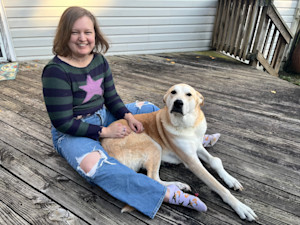
Savannah Admire
Savannah Admire is a writer and pet mom to two dogs and a cat. Under the name Savannah Cooper, she has published poetry in 40 different publications, as well as a poetry book, Mother Viper (2025). When she’s not writing, you can find her reading, taking photos, or volunteering as a content creator for her local community theatre. As a pets writer, she focuses on cat and dog behavior and pet parenthood. She currently lives in Western Maryland.
Related articles
How to Train a Dog Not to Jump
Kinship Collective dog trainer Robert Haussmann’s pro tips for getting a hyped-up dog to chill out.
![shy dog frightened in the arms of the owner. this brown mixed-breed hound puppy has a sweet gaze. the female owner has a wool sweater]()
Why Is My Dog Shaking? Causes and Treatment
A vet explains why the weather isn’t always to blame.
![Afghan hound dog mid jump in an open grass field]()
Overexcited Dog? How to Calm A Dog Down
If your dog loses their sh*t over anything—from a squirrel to a guest. Here are some tips to curtail that.
![Woman playing with her dog and his ball outside.]()
Why Does My Dog Foam at the Mouth?
When to see a vet and when you shouldn’t panic.
Can Dogs Communicate With Each Other?
It’s about more than barking.
Why Does My Dog Walk Sideways?
It may not be anything serious, but you should understand the causes.


